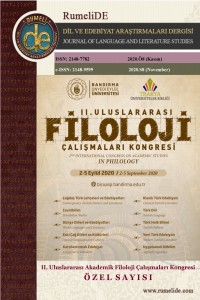Abstract
One of the most appealing but also frightening mythical beings is vampires. The myth of vampires goes back to Babylon. First vampires are known as Babylon vampires, Ekimmus. Many ancient societies had vampire myths and in those myths, vampires were described as evil creatures which fed on the human soul or their blood. Moreover, the most well-known vampire is a fictional character, Count Dracula, in the book, Dracula, written by Bram Stoker in 1897. Bram Stoker was inspired by Vlad Dracula, the brutally cruel ruler of Walachia, Romania. The reason why Count Dracula is the best-known vampire is that the book, Dracula, is probably one of the most adapted works of literature. One of them is Bram Stoker’s Dracula (1992) produced and directed by Francis Ford Coppola and the other one is Horror of Dracula (1958) directed by Terence Fisher. Thus, the aim of this article is to discuss the similarities and differences between the adapted works of Coppola and Fisher and the source text, Bram Stoker’s epistolary novel, Dracula.
Keywords
References
- Bernard, Veronika. (2011). A Semiotic analysis of colours and symbolic imagery in Francis Ford Coppola’s Bram Stoker’s Dracula (1992). Cinej Cinema Journal, Special Issue: 1. (https://www.researchgate.net/publication/274154490_The_Language_of_Colours_A_Semiotic_Analysis_of_Colours_and_Symbolic_Imagery_in_Francis_Ford_Coppola's_Bram_Stoker's_Dracula_1992. Accessed 04 April 2020.
- Bram Stoker’s Dracula. Directed by Francis Ford Coppola, performances by |Gary Oldman, Winona Ryder, Anthony Hopkins, and Keanu Reeves, Colombia Pictures, 1992 . Dick, Bernard F. (1990). The anatomy of film. New York: St. Martin's Press.
- Halberstam, Jake. (2020) Parasites and perverts: An introduction to the gothic monstrosity. Jeffrey Andrew Weinstock (Ed.), The Monster Theory Reader (180-188) University of Minnesota Press . Hutcheon, Linda. (2006). A Theory of adaptation. New York: Routledge.
- Stam, Robert. (2005). Literature and film: A guide to the theory and practice of film adaptation. Oxford: Blackwell.
- Stoker, Bram. (2017) Dracula. Istanbul: MK Publications............................................
Bram Stoker'in Drakulası ve Drakula'nın Dehşeti film uyarlamalarının Drakula romanı ile karşılaştırılması
Abstract
En çekici ama aynı zamanda korkutucu efsanevi varlıklardan biri vampirlerdir. Vampir efsanesi Babil’e kadar uzanmaktadır. İlk vampirler, Babil vampiri olarak bilinen Ekimmus’tur. Pek çok eski çağ toplumlarında vampir efsaneleri vardı ve bu efsanelerde vampirler insan ruhu veya kanından beslenen kötü yaratıklar olarak tasvir ediliyordu. Bununla birlikte, en tanınmış vampir 1987’de Bram Stoker tarafından yazılmış olan Drakula adlı eserindeki kurgusal bir karakter olan Kont Drakula’dır. Bram Stoker, Romanya’daki Walachia’nın zalim hükümdarı Vlad Drakula’dan esinlenmiştir. Kont Drakula’nın en bilindik vampire olmasının nedeni, Drakula kitabının en cok uyarlanmış edebi eserlerden biri olmasıdır. Bunlardan biri Francis Ford Coppola’nın yapımcılığı ve yönetmenliğini yaptığı Bram Stoker’a ait Drakula, diğeri ise Terrence Fisher’ın yönettiği Drakula’nın Dehşeti’dir. Bu makalede, kaynak metin olan Bram Sotoker’ın Drakula romanı ile Coppola ve Fisher’ın film uyarlamalarının arasındaki benzerlikler ve farklılıklar tartışılmıştır.
Keywords
References
- Bernard, Veronika. (2011). A Semiotic analysis of colours and symbolic imagery in Francis Ford Coppola’s Bram Stoker’s Dracula (1992). Cinej Cinema Journal, Special Issue: 1. (https://www.researchgate.net/publication/274154490_The_Language_of_Colours_A_Semiotic_Analysis_of_Colours_and_Symbolic_Imagery_in_Francis_Ford_Coppola's_Bram_Stoker's_Dracula_1992. Accessed 04 April 2020.
- Bram Stoker’s Dracula. Directed by Francis Ford Coppola, performances by |Gary Oldman, Winona Ryder, Anthony Hopkins, and Keanu Reeves, Colombia Pictures, 1992 . Dick, Bernard F. (1990). The anatomy of film. New York: St. Martin's Press.
- Halberstam, Jake. (2020) Parasites and perverts: An introduction to the gothic monstrosity. Jeffrey Andrew Weinstock (Ed.), The Monster Theory Reader (180-188) University of Minnesota Press . Hutcheon, Linda. (2006). A Theory of adaptation. New York: Routledge.
- Stam, Robert. (2005). Literature and film: A guide to the theory and practice of film adaptation. Oxford: Blackwell.
- Stoker, Bram. (2017) Dracula. Istanbul: MK Publications............................................
Details
| Primary Language | English |
|---|---|
| Subjects | Linguistics |
| Journal Section | World languages, cultures and litertures |
| Authors | |
| Publication Date | November 21, 2020 |
| Published in Issue | Year 2020 Issue: Ö8 |

